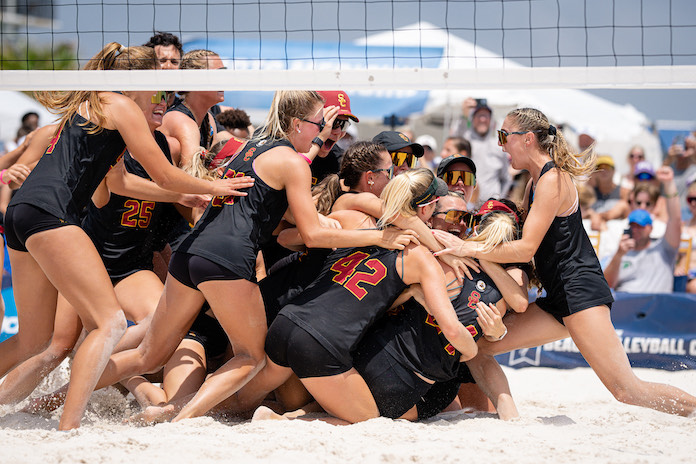In this first of two parts previewing the NCAA beach volleyball season, Coach Evan Silberstein tells us why his Hawaii team of the Big West could be the surprise of the season. We also extoll the virtues of USC as it ponders a four-peat, and look at chief rival UCLA and the rest of the powerful Pac-12. Finally, we review the compact-but-potent CCSA.
BeachBow’s strength in numbers
Evan Silberstein wore a broad smile and a knowing look during a Zoom call when the conversation turned to the subject of Hawaii’s deep roster.
“This is the most depth we have had in some time,” Silberstein said, his voice reflecting the excitement of a program that appears poised for a big season. “This will be my third year as head coach and my 10th in the program. We have to overcome a huge loss at No. 1 with (All-American) Brooke Van Sickle gone, but we have really good depth, and not just in the first five (courts).
“We have athletes on the exhibition (courts) at 6 and 7 that will be pushing and ready. If we’re not performing, we won’t have to just stick with the same 10.”
Such wealth of talent typically separates the elite teams capable of winning in the last three rounds of the NCAA Beach Championships during the first weekend of May from those that are just pretty good.
Fans more familiar with traditional “bracket” tournaments tend to focus on the stars – and the few rare talents who might project to the proverbial next level — but collegiate beach volleyball in the dual format is a pure team sport. It ranks among the most democratic of all team sports in that the result from each of the five courts counts equally. The match victory by the “top pair” on court 1 is worth the same one point as that of the “fifth-best” on court 5.
The key to a program’s success doesn’t necessarily hinge on one or two great players. Having six or seven key contributors up and down the five courts who can get the team to the crucial third match victory can be more important.
Hawaii advanced to the NCAA semifinals in 2016 and ‘17, but has been more of a middle-of-the-top-20 squad over the last three seasons. Seeded 13th in the 2023 NCAAs after receiving an at-large bid to the 17-team field, the Rainbow Wahine were bounced in the opening round by Loyola Marymount 3-1, with Cami Loker and Riley Wagoner (court 2) posting their lone match victory.
But with a balance of experience, an abundance of height…
Click Here to Read the Full Original Article at Volleyballmag.com…

